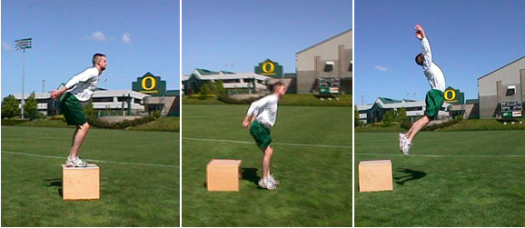Depths jumps are an extremely popular exercise, but also an extremely finicky exercise. If they are not done right they can lead to an improper stimulus (not actually training what you want) and even injury. In order to understand how to use depth jumps, we first have to understand why we use them.

Why
Depths jumps are used as one of the highest forms of stimulus of the stretch shortening cycle (Click here for details on the stretch shortening cycle ). They are used to train the most reactive qualities of the human body (nervous system, muscles, tendons, fascia etc..). The key word in understanding how to properly perform depth jumps is reactive. In this case, reactive means a sudden response (the jump upward) to a stimulus (the landing before the jump). Knowing this, it should be relatively simple to determine what box heights are best.

Selecting Box Heights
Selecting proper box heights for depth jumps is heavily predicated on the reactive strength index (RSI) of the jump. The RSI is simply the jump height divided by the ground contact time. This means as long as the athlete can sustain a high vertical jump height and a low ground contact time from the box height they are jumping off of, then you will be okay. However, if the RSI begins to decrease and ground contact time begin to increase, then you know you have too high of a box. This can easily be noticed with good observation, but you can also use equipment to quantify the jump height.
Formulas
RSI = Jump height / ground contact time
Impulse –> Force*time= Mass*(final velocity – initial velocity)
Relating This To Physics
RSI and impulse are very closely intertwined (if you don’t know what impulse is click here). If jump height remains the same, we know impulses are the same. However, if jump height remains the same and ground contact times are different (one ground contact is longer than the other), we know that the development of impulse is different. The one with the longer ground contact time is now more greatly influenced by the time force is being expressed (time on the left side of above equation), instead of the amount of force being expressed.

Elite trained athletes produce a greater RSI at a higher box height. a low ground contact time means the impulse is driven by force and not time force is being expressed
If RSI remains high from a box jump, we know that the acute production of force (reaction to the ground) will be high and the contribution of “time” that force is expressed will be lower (low ground contact time). By limiting the time variable and keeping the RSI hight, we are making this movement much more reactive without jeopardizing the jump heights. The minute RSI drops and ground contact time increases (time variable of impulse increases and total force decreases) there is a possibility that we are no longer getting the desired training stimulus.
Understand why the right stimulus is important (CLICK HERE)
Conclusion
Box Heights for depth jumps should be selected based on the athlete’s ground contact time and jump height. When one of those two variables are hindered due to height of the box, you know you have gone too high.
- Image 1: https://surfathleticscrossfit.wordpress.com/tag/depth-jump/
- Image2: http://www.balegoonline.org/index.phpmain_page=product_info&products_id=281
- Image3: https://www.researchgate.net/publication/232212864_The_Use_of_Contact_Time_and_the_Reactive_Strength_Index_to_Optimize_Fast_Stretch-Shortening_Cycle_Training
